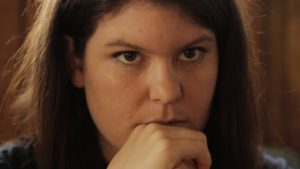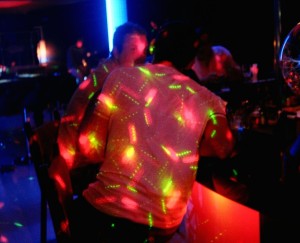The thing about readings, or events with readings in them is often that what is being read doesn’t necessarily do much different to the content being read than would be experienced on a page, online or on paper. That’s not to misunderstand the basic fact of ‘liveness’ and how different that medium is to reading in your own time –but it seems that at the moment there is not enough of a distinction between work that is meant to be read and work that is meant to be read!
The words read out at Gathering Place, the evening organised on February 25 by Caspar Heinemann held at London’s ANDOR Gallery and featuring live readings by Mira Mattar, Nat Raha and Penny Goring, were completely lifted, necessary, painful, important, big, small, and received by the people there. They were given into the room.
The words in Goring’s piece for the evening are defensive, protective, strong, sore and tender, but her singing of them too, to a repeat and memorable nursery rhyme tune feels like a very real strategy in order to be present with the work in the room –for the artist, and in turn, for us. This runs throughout the evening and is what allows it be a good Gathering Place.
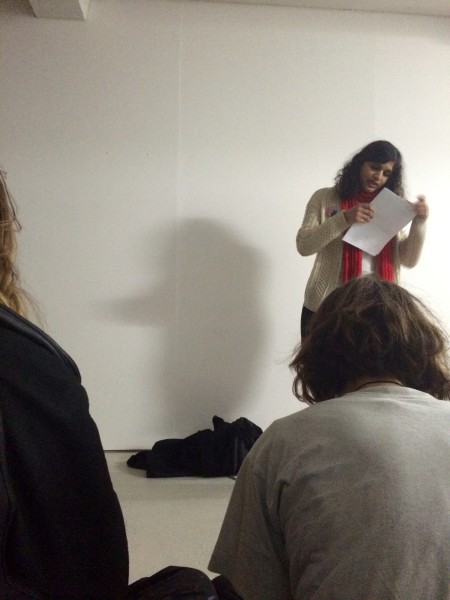
There are many people here, talking, meeting and drinking the free gin & tonics. The smell is absolutely incredible, it’s aggressive. It is a work by Alex Margo Arden and is most present in the space between the first room and second room, where the readings take place. It is on the verge of being slightly nauseating. It is on the verge of being slightly intoxicating. It is possibly the smell of hot rubber or rubber that has had friction applied to it, rubber that has skipped straight past the fire part and is just smoking quietly.
In the short piece Heinemann has written to introduce the event, they mention that architecture should inspire and innovate: “I defend to the death the right to smoke weed on children’s play equipment”. The phrase makes me think quickly to the promotional image used for Gathering Place (below), which is a photograph of a work by Alex Margo Arden, although the work is not in this space. Ropes wrap around hooks and end up like pink buds that give out lines and shadows to form a silhouette of a climbing frame or something like that on the wall behind.
What holds each of the four pieces of writing together is a lament or narrative or, occasional homage to the destruction of everything, innovation, luxury, struggle, desire, deficit and fantasy. I wonder briefly, sitting there on the floor with everyone else, about using words like weights or punches to criticise things that are the definition of, or that actively define and oppress structures. A thought occurs about destroying words; and then about the fact that thoughts like that often form as the direct result of listening to powerful ones that are spoken by someone with a deep understanding of both their destructive and constructive power.
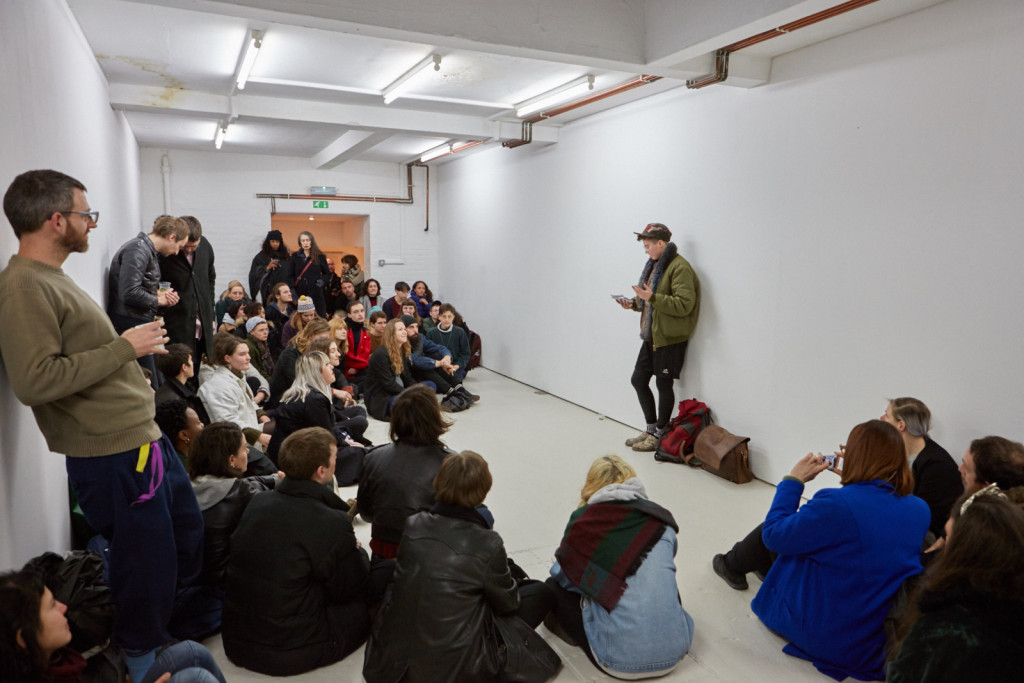
Mira Mattar silently approaches the wall she leans against to speak. She reads two sides of a single piece of paper without averting her gaze from it and without pausing for reaction or effect. The silence Mattar commands is stunning and precious and no one breaks it. She reads like she is under and also performing a spell, but for something/somewhere other than the audience; we watched. The writing is memory, and remembering with occasional marks of self awareness. “I am plotting a solitude that is neither thin escape nor shallow respite,” she says as though she invisibly lifts her head into the present moment –although all of it is read in the present tense –before dipping back into describing, “a silver fish rims sickly the edge of a toilet bowl”.
“Trains/ tunnels/ ports/ movements/ the violent fictional nation/ lyric choke”. Nat Raha’s reading is long and difficult and that feels intentional. She moves like she’s battling when she reads. She reads out lists of painful things, pain, recent histories, acts of police racism and violence, lists of people affected by “the economic” and it is hard to follow and hard to access, but, so are the “inaccessible homes of the economic”. And so is it for the family of “Sarah Reed and Mark Duggan” and trans women of colour in Greenwich prison marginalised: “whose being does legislation [and words and understanding and accessibility] represent?”
Raha’s words leave no traces of words. The words are almost physical acts or marks of replenishing holes, or naming and listing where names and lists have not been. There is no residue left in the performance, no poetic excess in which the words might point elsewhere, because her words are like people and bodies, they are present, here and urgent.
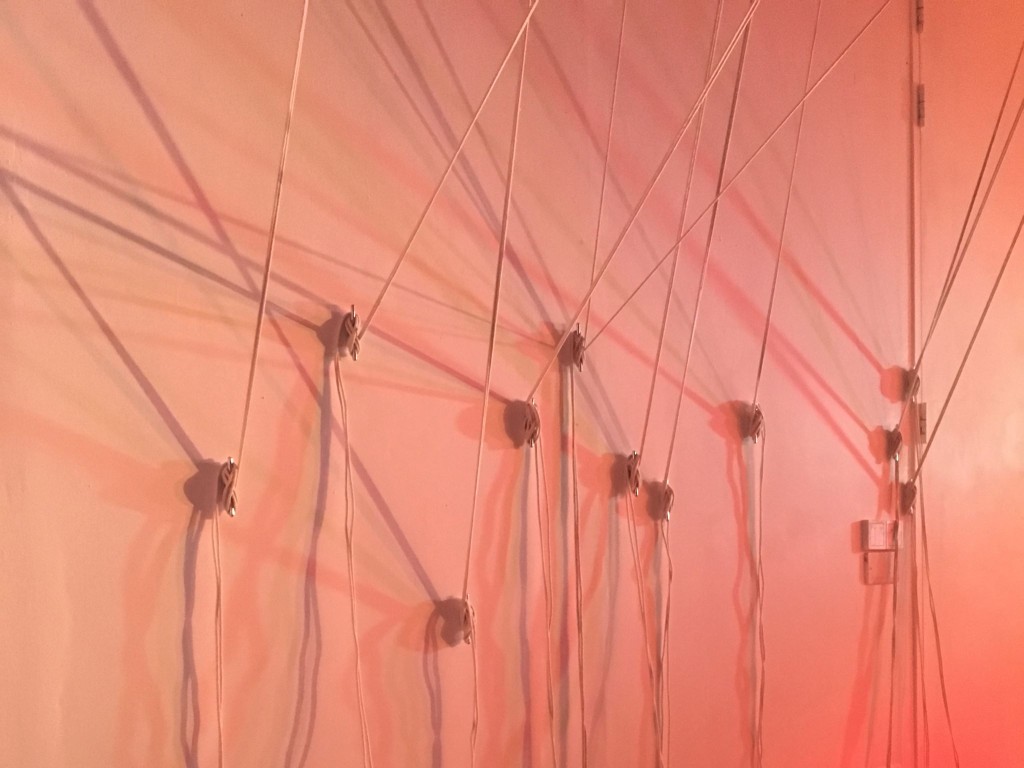
“In my bone dust disco” comes about half way through Penny Goring’s long poem and it stays in the air, her voice so, so sad and her words able to carry and cradle expression and indescribable feeling like the fragrance by Arden that seems to be getting stronger now too. She sometimes stops, kneeling slowly down to carry on, or standing slowly up to drink some water. We are totally in her time and she’s singing us a long tale that she’s told before somewhere, I think. Mainly it feels like a tale of a failing body holding it together (even) in intimacy to look after another.
After the final reading by London-based Goring I speak with her about what it is to sing words as well as say them, and if it maybe helps the author sit with the words better in a live moment: when people want your words most and when you don’t know if you can listen to them out loud anymore.**
